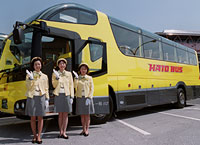|
|
|||||||
|
|
|||||||
|
|||||||
| | Web Japan >>| Trends in Japan >> | Lifestyle >> | Touring Tokyo | |
|
TOURING TOKYO Bus Tours Offer Unrivaled Access to Capital's Sights (April 18, 2003) One element of the Tokyo streetscape that is hard to miss is the giant black-and-yellow coaches of Hato Bus Co., a well-known bus-tour provider that has operated in the city for over 50 years. Hato buses play a role similar to that of New York City's Gray Line and London's open-top double-deckers. Although Hato experienced a slump in business for a time, its daytrips around the city and its environs have recently been making a comeback. The company's recent route adjustments, which were based on the findings of detailed customer surveys, appear to be paying off.
New Sightseeing Routes Hato also purchased new vehicles for its fleet. In making this purchase, the company took very seriously a comment it had received from passengers: that being able to look down at the coaches of other companies from a tour-bus window gave them a sense of superiority. In response to this feedback, Hato invested an extra ¥2 million ($16,667 at ¥120 to the dollar) in each of its new buses to have the seats raised by 5 centimeters. The company's determined efforts to boost customer satisfaction helped to reverse its decline, and at the end of the June 2002 business term, Hato Bus was able to resume dividend payments to shareholders.
Tours to Suit Every Taste Among the firm's other packages are one that features lunch at a restaurant in Yokohama's Chinatown and one that includes a day pass to Tokyo Disneyland. Other tours feature trips to watch sumo or baseball or to see a traditional Japanese garden. By offering a window on aspects of city life that are not readily accessible to ordinary individuals, Hato Bus tours have found favor not only among visitors to Tokyo but also among residents of the capital.
Tea Ceremony and Kabuki Popular Among Foreign Tourists Hato, which prides itself on showcasing Tokyo as a vibrant international city, is striving to develop new products that will further delight its growing ranks of satisfied customers. Related Web SitesHato Bus Co. Copyright (c) 2004 Web Japan. Edited by Japan Echo Inc. based on domestic Japanese news sources. Articles presented here are offered for reference purposes and do not necessarily represent the policy or views of the Japanese Government. |
CENTRAL TOKYO REBORN (June 19, 2003) EDO BIRTHDAY BASH (April 16, 2003) A STEAMING HOT BUSINESS (December 20, 2002) |
|
|



